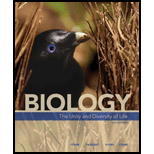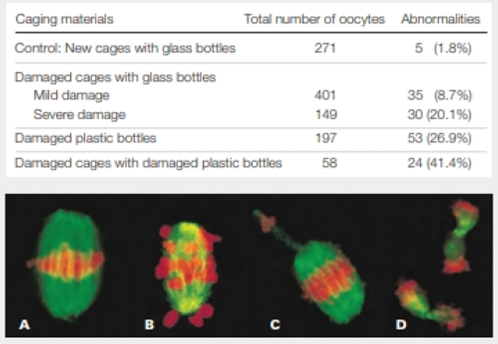
Concept explainers
BPA and Abnormal Meiosis In 1998, researchers at Case Western University were studying meiosis in mouse oocytes (germ cells) when they saw an unexpected and dramatic increase of abnormal events (FIGURE 12.6). Improper segregation of chromosomes during meiosis is one of the main causes or human genetic disorders.
The spike in abnormal meiosis began right after the mouse facility started washing the animals' plastic cages and water bottles in a new, alkaline detergent. The detergent had damaged the plastic, which as a result was leaching bisphenol A (BPA). BPA is a synthetic chemical that mimics estrogen, the main female sex hormone in animals. Though it has since been banned for use in baby bottles, BPA is still widely used to manufacture other plastic items and epoxies (such as the coating on the inside of metal cans of food). BPA-free plastics are often manufactured with a related compound, bisphenol S (BPS), that has effects similar to BPA.

FIGURE 12.6 Abnormalities in meiosis that occurred after exposure to BPA.
Top, the most abnormal meiosis events occurred in mice that were housed in damaged plastic caging with damaged plastic bottles. Damaged plastic releases BPA.
Bottom, fluorescent micrographs show the chromosomes (red) and spindle (green) in nuclei of mouse germ cells in metaphase I. A Normal metaphase; B–D abnormal metaphase.
What percentage of mouse oocytes displayed abnormalities of meiosis with no exposure to damaged caging?
To determine: The percentage of the mice that had the most abnormalities in their oocytes with no exposure to damaged caging.
Introduction: A synthetic chemical called bisphenol A (BPA) imitates the female sex hormone—estrogen that is found in the animals. Bisphenol A is used in the manufacturing of different plastics including polycarbonate plastics such as dental sealants, baby bottles, and food and drink containers. Research studies show that these chemicals possess the capability to disrupt the meiotic division and then damage the reproductive function of the organism (experiments conducted in the mice oocytes).
Explanation of Solution
In the given experiment, researchers had found that a changed alkaline detergent caused damage to the plastic and resulted in the leaching of BPA chemical. BPA that mimics as estrogen hormone induces meiotic abnormalities in the mice oocyte.
The experiment was conducted with a plastic damaged cage and a new cage as the control. Along with that, they used glass bottles as control with the damaged one. The study showed the following:
- Abnormalities in mice oocyte placed in a new cage with glass bottle were 1.8%.
- Mildly damaged cage with glass bottles were 8.7%, and severely damaged cage with glass bottles was 20.1%.
- The abnormalities associated with damaged plastic bottles alone were 26.9%.
- In the damaged cages with the damaged plastic bottles, it was observed that the abnormality rates were 41.4%.
Out of 271 mice oocytes, only 5 out of them showed the abnormalities. When this was converted to a percentage, it accounts for about 1.8%. Hence, the researchers concluded that the mice oocytes that had most abnormalities of meiosis with no exposure to the damaged cage were about 1.8%.
About 1.8% of mice oocytes that were exposed to damaged cages had most abnormalities of meiosis.
Want to see more full solutions like this?
Chapter 12 Solutions
Biology: The Unity and Diversity of Life (MindTap Course List)
Additional Science Textbook Solutions
Chemistry
Genetics: From Genes to Genomes
Campbell Essential Biology (7th Edition)
HUMAN ANATOMY
Chemistry: A Molecular Approach (4th Edition)
Biology: Life on Earth with Physiology (11th Edition)
- What are some external influences that keep people from making healthy eating decisions?arrow_forwardWhat type of structure(s) would you expect to see in peripheral membrane proteins? (mark all that apply) A. Amphipathic alpha helix (one side is hydrophilic and one side is hydrophobic) B. A hydrophobic beta barrel C. A hydrophobic alpha helix D. A chemical group attached to the protein that can anchor it to the membranearrow_forwardTemporal flexibility (the ability to change over time) of actin structures within a cell is maintained by… A. The growth/shrinkage cycle B. Periodic catastrophe C. GTP hydrolysis D. Treadmilling E. None of the abovearrow_forward
- During in vitro polymerization of actin and microtubule filaments from their subunits, what causes the initial delay in filament growth? A.Nucleation B.Reaching homeostasis C.Nucleotide exchange D.ATP or GTP hydrolysis E.Treadmillingarrow_forwardYou expect to find which of the following in the Microtubule Organizing Center (MTOC)...(mark all that apply) A. Gamma tubulin B. XMAP215 C. Centrioles D. Kinesin-13arrow_forwardThe actin-nucleating protein formin has flexible “arms” containing binding sites that help recruit subunits in order to enhance microfilament polymerization. What protein binds these sites? A.Thymosin B.Profilin C.Cofilin D.Actin E.Tropomodulinarrow_forward
- While investigating an unidentified motor protein, you discover that it has two heads that bind to actin. Based on this information, you could confidently determine that it is NOT... (mark all that apply) A. A myosin I motor B. A dynein motor C. A myosin VI motor D. A kinesin motorarrow_forwardYou isolate the plasma membrane of cells and find that . . . A. it contains regions with different lipid compositions B. it has different lipid types on the outer and cytosolic leaflets of the membrane C. neither are possible D. A and B both occurarrow_forwardYou are studying the mobility of a transmembrane protein that contains extracellular domains, one transmembrane domain, and a large cytosolic domain. Under normal conditions, this protein is confined to a particular region of the membrane due to the cortical actin cytoskeletal network. Which of the following changes is most likely to increase mobility of this protein beyond the normal restricted region of the membrane? A. Increased temperature B. Protease cleavage of the extracellular domain of the protein C. Binding to a free-floating extracellular ligand, such as a hormone D. Protease cleavage of the cytosolic domain of the protein E. Aggregation of the protein with other transmembrane proteinsarrow_forward
- Topic: Benthic invertebrates as an indicator species for climate change, mapping changes in ecosystems (Historical Analysis & GIS) What objects or events has the team chosen to analyze? How does your team wish to delineate the domain or scale in which these objects or events operate? How does that limited domain facilitate a more feasible research project? What is your understanding of their relationships to other objects and events? Are you excluding other things from consideration which may influence the phenomena you seek to understand? Examples of such exclusions might include certain air-born pollutants; a general class of water bodies near Ottawa, or measurements recorded at other months of the year; interview participants from other organizations that are involved in the development of your central topic or issue. In what ways do your research questions follow as the most appropriate and/or most practical questions (given the circumstances) to pursue to better understand…arrow_forwardThe Esp gene encodes a protein that alters the structure of the insulin receptor on osteoblasts and interferes with the binding of insulin to the receptor. A researcher created a group of osteoblasts with an Esp mutation that prevented the production of a functional Esp product (mutant). The researcher then exposed the mutant strain and a normal strain that expresses Esp to glucose and compared the levels of insulin in the blood near the osteoblasts (Figure 2). Which of the following claims is most consistent with the data shown in Figure 2 ? A Esp expression is necessary to prevent the overproduction of insulin. B Esp protein does not regulate blood-sarrow_forwardPredict the per capita rate of change (r) for a population of ruil trees in the presence of the novel symbiont when the soil moisture is 29%. The formula I am given is y= -0.00012x^2 + 0.0088x -0.1372. Do I use this formula and plug in 29 for each x variable?arrow_forward
 Biology Today and Tomorrow without Physiology (Mi...BiologyISBN:9781305117396Author:Cecie Starr, Christine Evers, Lisa StarrPublisher:Cengage Learning
Biology Today and Tomorrow without Physiology (Mi...BiologyISBN:9781305117396Author:Cecie Starr, Christine Evers, Lisa StarrPublisher:Cengage Learning Human Heredity: Principles and Issues (MindTap Co...BiologyISBN:9781305251052Author:Michael CummingsPublisher:Cengage Learning
Human Heredity: Principles and Issues (MindTap Co...BiologyISBN:9781305251052Author:Michael CummingsPublisher:Cengage Learning Biology: The Dynamic Science (MindTap Course List)BiologyISBN:9781305389892Author:Peter J. Russell, Paul E. Hertz, Beverly McMillanPublisher:Cengage Learning
Biology: The Dynamic Science (MindTap Course List)BiologyISBN:9781305389892Author:Peter J. Russell, Paul E. Hertz, Beverly McMillanPublisher:Cengage Learning Human Biology (MindTap Course List)BiologyISBN:9781305112100Author:Cecie Starr, Beverly McMillanPublisher:Cengage Learning
Human Biology (MindTap Course List)BiologyISBN:9781305112100Author:Cecie Starr, Beverly McMillanPublisher:Cengage Learning Biology: The Unity and Diversity of Life (MindTap...BiologyISBN:9781305073951Author:Cecie Starr, Ralph Taggart, Christine Evers, Lisa StarrPublisher:Cengage Learning
Biology: The Unity and Diversity of Life (MindTap...BiologyISBN:9781305073951Author:Cecie Starr, Ralph Taggart, Christine Evers, Lisa StarrPublisher:Cengage Learning Biology 2eBiologyISBN:9781947172517Author:Matthew Douglas, Jung Choi, Mary Ann ClarkPublisher:OpenStax
Biology 2eBiologyISBN:9781947172517Author:Matthew Douglas, Jung Choi, Mary Ann ClarkPublisher:OpenStax





